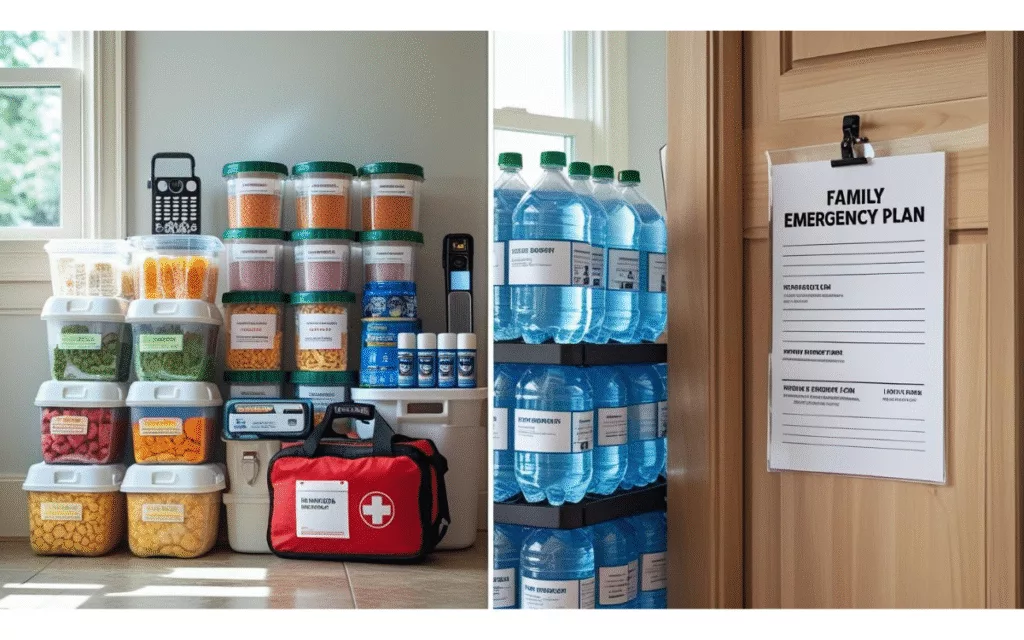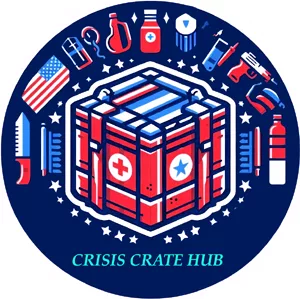Table of Contents

Emergency preparedness can sometimes feel overwhelming, but breaking it down into emergency kits and home safety plans makes it easier to tackle. These two elements serve different purposes but work hand-in-hand to keep families safe and ready for anything nature or life throws our way.
Emergency kits are all about having the essentials you might need on-hand – things like water, food supplies, or even medical necessities. Imagine those times when going out just isn’t an option, whether it’s a blizzard or major power outage. Having those emergency supplies stashed away gives you the buffer you need to ride out short-term situations without too much hassle.
Meanwhile, a home safety plan deals with the ‘what if’ scenarios. It’s like your family’s guidebook for navigating unexpected events confidently. It’ll include how you will communicate during emergencies, where everyone should head if the house isn’t safe, and how to tackle the likes of fires or floods. Knowing your game plan keeps everyone on the same page and reduces panic. Plus, when family members have rehearsed their roles, they’re more likely to keep cool under pressure.
Together, these emergency kits and plans ensure you have both the supplies and strategy needed to protect yourselves. Basically, think of kits as your lifeline to immediate needs, while the plan is your roadmap to longer-term safety.
Do You Really Need an Emergency Kit?

When thinking about an emergency kit, you might wonder if it’s really worth it. Honestly, it all boils down to peace of mind and being prepared, because unexpected things happen – freak storms, power cuts, or even impromptu camping trips gone wrong.
Consider this: having an emergency kit means you’re ready for those days when you can’t just pop out to the store. Think about essentials like food, water, and basic first-aid. In critical situations, having supplies on hand can mean the difference between stress and security, or even life or death.
Some people might say having a kit is overkill – we live in a modern world, right? But even in well-equipped cities, help might take time to reach you during widespread emergencies. Plus, why not have a bit of extra preparedness in your pocket? It’s not just for catastrophic events but everyday hassles too.
Maybe you’ve got a story where being prepared saved the day, or perhaps you’ve heard a friend’s tale where having a kit made challenges just a little bit easier. There’s a comforting logic in being ready for anything life might unexpectedly chuck your way.
Think about the cost of putting a kit together as an investment in safety. It might seem like an initial expense, but the potential benefits far outweigh the costs. At the end of the day, knowing you’ve got what you need provides a little piece of calm in the chaos, and who doesn’t want that?
What Should Be Included in a Family Emergency Kit?

Putting together a family emergency kit doesn’t have to be complicated, and it’s a great step toward being prepared. Start with the basics: water, food, and medical supplies. You want enough to cover your family for at least 72 hours. Non-perishable food items that require little to no preparation are the way to go.
Don’t forget first-aid essentials. Bandages, antiseptics, and any personal medications should be included. Add a flashlight and extra batteries; you’ll need these if the power’s out. A battery-powered radio is also essential for keeping up with emergency broadcasts.
Comfort items often get overlooked. Pack a few blankets or sleeping bags, not just for warmth but also for a bit of comfort. Remember, staying cozy and safe lifts spirits when faced with uncertainty.
Consider who you’re packing for. Young kids might need specific foods, diapers, or favorite toys, while pets will need their own food and water supplies. If anyone in the family has special medical needs, customize accordingly – think of it as personalizing security for those unique situations.
Finally, important documents like ID copies, insurance papers, and emergency contact lists should be part of your kit. Just make sure they’re waterproofed – a simple plastic bag can do the trick. Preparing your kit this way means you’re ready for whatever comes your way, and you’ll sleep a little better knowing all bases are covered.
Building a Comprehensive Family Emergency Plan
Creating a solid family emergency plan might sound daunting, but once it’s done, you’ll feel a whole lot safer. The plan should start with clear communication strategies. Everyone needs to know how to reach each other when regular means like cell phones aren’t an option.
Identify meeting points ahead of time. It’s smart to decide on both a spot near your home and one a bit farther away, just in case getting home isn’t safe. These predetermined locations help your family regroup quickly and safely.
Evacuation routes are another key. Find the best paths out of your home and neighborhood. Walk them, drive them, get to know them. You’ll want to practice these routes so they’re second nature to everyone during an emergency.
Make sure your plan considers different scenarios. Whether it’s a natural disaster, health emergency, or something unexpected, each situation might require unique responses. Discuss these plans with everyone, so there are no surprises.
Involving all family members in creating the plan is crucial. Kids can often feel left out, but explaining their roles and responsibilities in an emergency can give them confidence and readiness.
Keeping updated copies of your plan accessible to everyone ensures no one’s left guessing when quick actions are needed. Review and rehearse your plan regularly to keep it fresh in everyone’s minds. You never know when having a clear, well-practiced plan will make all the difference in an emergency.
Advantages of Having a Survival Kit at Home

Having a survival kit at home isn’t just about being prepared; it’s about peace of mind. Knowing you’re ready for the unexpected brings a comforting sense of confidence. Whether it’s those surprise storms or something bigger, when you’re set with essentials on hand, tackling these becomes manageable.
Think of a kit as your toolkit for life’s unexpected curveballs. It lets you navigate emergencies without the stress of scrambling for supplies. You can act quickly, knowing that essential items are right where you left them, ready to be used in a heartbeat.
Another big plus is that a well-stocked kit can help prevent minor issues from blowing up into big problems. Have a first-aid kit on hand, and you can easily take care of little injuries before they become major concerns. Keep non-perishable food ready to eat, and you won’t need to worry if getting to the store isn’t an option.
A survival kit also takes a load off when it comes to making decisions under pressure. With resources at your disposal, you can focus on more important choices about safety and comfort, rather than scrounging around for necessities.
Ultimately, being prepared reduces anxiety. In emergencies, stress is already high, and taking concerns about immediate needs off your plate can haven’t a huge impact on your ability to cope. Creating a survival kit is a simple step you can take today, one that pays dividends in terms of safety and serenity whenever life gets unpredictable.
